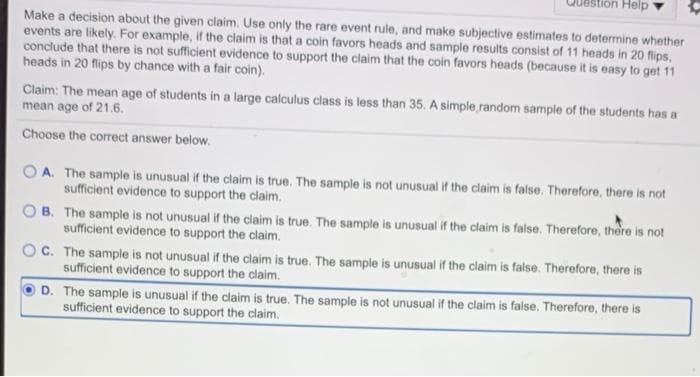Help Make a decision about the given claim. Use only the rare event rule, and make subjective estimates to determine whether events are likely. For example, if the claim is that a coin favors heads and sample results consist of 11 heads in 20 flips, conclude that there is not sufficient evidence to support the claim that the coin favors heads (because it is easy to get 11 heads in 20 flips by chance with a fair coin). Claim: The mean age of students in a large calculus class is less than 35. A simple random sample of the students has a mean age of 21.6. Choose the correct answer below. OA. The sample is unusual if the claim is true. The sample is not unusual if the claim is false. Therefore, there is not sufficient evidence to support the claim. B. The sample is not unusual if the claim is true. The sample is unusual if the claim is false. Therefore, there is not sufficient evidence to support the claim. C. The sample is not unusual if the claim is true. The sample is unusual if the claim is false. Therefore, there is sufficient evidence to support the claim. D. The sample is unusual if the claim is true. The sample is not unusual if the claim is false. Therefore, there is sufficient evidence to support the claim.
Help Make a decision about the given claim. Use only the rare event rule, and make subjective estimates to determine whether events are likely. For example, if the claim is that a coin favors heads and sample results consist of 11 heads in 20 flips, conclude that there is not sufficient evidence to support the claim that the coin favors heads (because it is easy to get 11 heads in 20 flips by chance with a fair coin). Claim: The mean age of students in a large calculus class is less than 35. A simple random sample of the students has a mean age of 21.6. Choose the correct answer below. OA. The sample is unusual if the claim is true. The sample is not unusual if the claim is false. Therefore, there is not sufficient evidence to support the claim. B. The sample is not unusual if the claim is true. The sample is unusual if the claim is false. Therefore, there is not sufficient evidence to support the claim. C. The sample is not unusual if the claim is true. The sample is unusual if the claim is false. Therefore, there is sufficient evidence to support the claim. D. The sample is unusual if the claim is true. The sample is not unusual if the claim is false. Therefore, there is sufficient evidence to support the claim.
Chapter8: Sequences, Series,and Probability
Section8.7: Probability
Problem 11ECP: A manufacturer has determined that a machine averages one faulty unit for every 500 it produces....
Related questions
Concept explainers
Contingency Table
A contingency table can be defined as the visual representation of the relationship between two or more categorical variables that can be evaluated and registered. It is a categorical version of the scatterplot, which is used to investigate the linear relationship between two variables. A contingency table is indeed a type of frequency distribution table that displays two variables at the same time.
Binomial Distribution
Binomial is an algebraic expression of the sum or the difference of two terms. Before knowing about binomial distribution, we must know about the binomial theorem.
Topic Video
Question

Transcribed Image Text:Help
Make a decision about the given claim. Use only the rare event rule, and make subjective estimates to determine whether
events are likely. For example, if the claim is that a coin favors heads and sample results consist of 11 heads in 20 flips,
conclude that there is not sufficient evidence to support the claim that the coin favors heads (because it is easy to get 11
heads in 20 flips by chance with a fair coin).
Claim: The mean age of students in a large calculus class is less than 35. A simple random sample of the students has a
mean age of 21.6.
Choose the correct answer below.
A. The sample is unusual if the claim is true. The sample is not unusual if the ciaim is false. Therefore, there is not
sufficient evidence to support the claim.
B. The sample is not unusual if the claim is true. The sample is unusual if the claim is false. Therefore, there is not
sufficient evidence to support the claim.
C. The sample is not unusual if the claim is true. The sample is unusual if the claim is false. Therefore, there is
sufficient evidence to support the claim.
D. The sample is unusual if the claim is true. The sample is not unusual if the claim is false. Therefore, there is
sufficient evidence to support the claim.
Expert Solution
This question has been solved!
Explore an expertly crafted, step-by-step solution for a thorough understanding of key concepts.
This is a popular solution!
Trending now
This is a popular solution!
Step by step
Solved in 3 steps

Knowledge Booster
Learn more about
Need a deep-dive on the concept behind this application? Look no further. Learn more about this topic, statistics and related others by exploring similar questions and additional content below.Recommended textbooks for you

